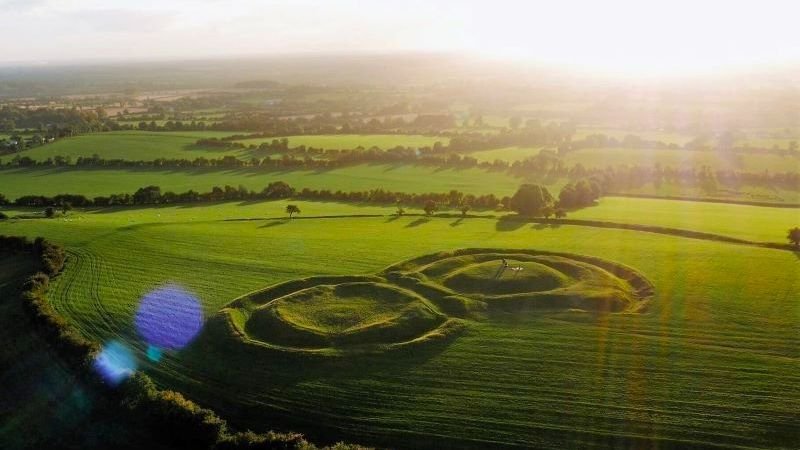Glasgow || Fairy Forts || Boyne Valley
“Let us be the ancestors our descendants will thank.”
-Winona LaDuke
Last week, we were thrilled to announce that Bog & Thunder joined the Glasgow Declaration on Climate Action in Tourism, a collective statement from ecotourism providers and destinations that both recognizes the urgency for action in our industry and outlines a commitment to change. The Declaration was formally launched at COP26; you can learn more about our commitments on the Mission page of our website.
It’s so easy to get overwhelmed by all of the information about the climate crisis we’ve been reading in the news, watching on television, and gleaning from social media feeds—particularly this past week or so, when the attention of the whole world is on Glasgow. We’ve seen some heads of state making bold commitments; others, not so much. Simon Kofe, the foreign affairs minister for Tuvalu, a Pacific Island nation, addressed the conference from a podium in the sea. You’d be forgiven for believing that the dire warnings from the leaders of the global north will translate into resolute action. How could they not, given the consequences of our collective inaction?
And yet, we also heard the intrepid Greta Thunberg call the climate summit a failure. On the opening day of the summit, a 24-year-old indigenous activist from Brazil named Taxi Suruí accused the heads of state present of closing their eyes to reality. Suruí said, “The Earth is speaking. She tells us that we have no more time.” The timeline for fossil fuel reduction set by world leaders is inadequate: “It’s not 2030 or 2050,” she said. “It’s now.”
So how do we know who to believe, and further, where to begin as citizens who wish to make change? Xiye Bastida speaks to this in her essay “Calling In”:
Some people feel like they have to know the science inside and out before they can talk about it or do something about it. But here’s what I have learned: You don’t have to know the details of the science to be part of the solution. And if you wait until you know everything, it will be too late for you to do anything.
Bastida’s essay is part of the anthology All We Can Save: Truth, Courage, and Solutions for the Climate Crisis, a collection of insight from diverse women who are amongst the leading voices in the American climate movement. What I like best about the book (apart from it being entirely composed of voices of people who identify as women) is that it is solutions-oriented. Rather than the doomsaying, apocalyptic narratives we are used to consuming via mainstream media, the anthology offers visions of the future that emphasize the life-giving possibilities of collective action.
Aerial view of the Hill of Tara, seat of the High Kings of Ireland.
In the meantime, climate change—and other human-led destruction—is affecting some of Ireland’s most significant historical and archeological sites. In Men Who Reap Ringforts, Sinéad Mercier, Michael Holly, and Eddie Lenihan detail the widespread destruction of “fairy forts” (also known as ringforts), Ireland’s most common archaeological feature. What, exactly, is a fairy fort? Mercier explains:
Generally speaking, on the island of Ireland, fairy forts are often considered to be manifestations of the mythological netherworld of ‘the good people’—na síoga in Gaelic, or in anglicised form, the sidhe or sí. These ‘fairies’ are not those creatures represented in mainstream Western literature as winged, pretty beings: na sióga are intimately connected to the landscape and part of an old animistic faith found in the spiritual nature of the land.
As Mercier explains, belief in na síoga is part of Irish storytelling culture, and that belief in fairies is still present across the island today. Most fairy forts are left alone entirely as a matter of respect; for example, farmers will plow their fields around them rather than remove them from their fields. And yet: though there are legal protections, due largely to the lack of law enforcement and those farmers who lack spiritual connection to the land, ringforts are being destroyed at an alarming rate. What once numbered more than 60,000, there are only an estimated 32,000 left.
An unexpected thing happened in the Boyne Valley in July of 2018. That summer, Ireland was experiencing record low levels of rainfall, the least amount in about 160 years. Inspired by crop marks that were being revealed adjacent to castles in Wales due to the heatwave, local man Anthony Murphy decided to fly a drone over the valley to see if he might be able to see anything new in his area. As luck would have it, Murphy’s drone captured images of an unknown henge (a prehistoric earthen ring or enclosure), which experts estimate to be about 4,500 years old.
It was an incredible find, made all the more significant due to its proximity to Brú na Bóinne, a UNESCO World Heritage site known for its Neolithic passage tombs, including Newgrange, Knowth, and Dowth. The chief archaeologist for Ireland’s National Monuments Service, Michael McDonagh, called Murphy’s find “once in a lifetime” due to its cultural significance. As it happened, during those hot and dry weeks that summer, the National Monuments Service received reports of sixty-five additional Neolithic and Iron Age sites discovered by drones (though none quite as significant).
While certainly exciting, for me it calls to mind a greater question, namely: What sort of impact will climate change have on Ireland’s rich cultural heritage? We will visit these sites and think about these questions and more on our tours.
Travel with us to the Boyne Valley and explore our ancient sites as part of the Megalithic Gastronomic tour (July 10-15, 2022) OR the Lughnasa tour (July 25-August 1, 2022).
What We’re Reading:
Kate: I just finished the short novel Open Water by Caleb Azumah Nelson, a British-Ghanian writer who lives in London. I hadn’t heard of it before I picked it up at the library, and it is incredible. Nelson’s writing is so powerful and heartfelt. Highly recommend it.
Max: I just picked up my copy of The Dawn of Everything, the late anarchist anthropologist David Graeber’s last book (with David Wengrow), published posthumously. I’m really looking forward to getting into it. His ideas always reveal, for me, fascinating new ways of looking at things that we take for granted.
What We’re Listening To:
We’re listening to Rhiannon Giddens’ latest release with Francesco Turrisi, They’re Calling Me Home. Both Max and I are long-time fans of Giddens, and we were thrilled to be able to see her live last night at the Michigan Theater—our first live music event in almost two years!


